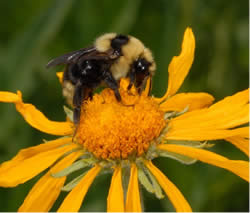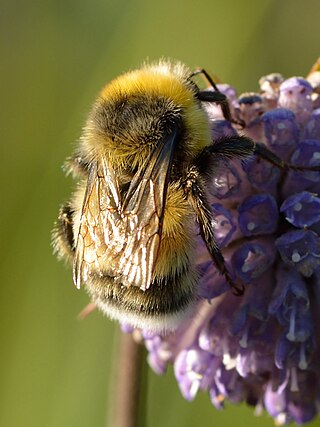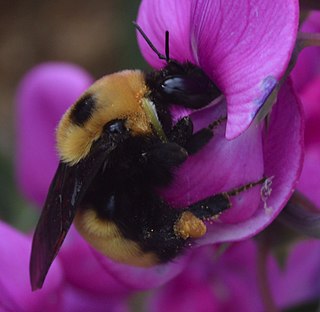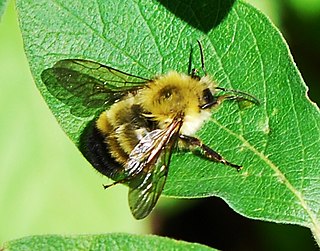
The early bumblebee or early-nesting bumblebee is a small bumblebee with a wide distribution in most of Europe and parts of Asia. It is very commonly found in the UK and emerges to begin its colony cycle as soon as February which is earlier than most other species, hence its common name. There is even some evidence that the early bumblebee may be able to go through two colony cycles in a year. Like other bumblebees, Bombus pratorum lives in colonies with queen and worker castes. Bombus pratorum queens use aggressive behavior rather than pheromones to maintain dominance over the workers.

Bombus barbutellus, or Barbut's cuckoo-bee, is a species of cuckoo bumblebee, widespread, if not especially common, in most of Europe.

Bombus citrinus is a species of bumblebee known commonly as the lemon cuckoo bumblebee due to its lemon-yellow color. It is native to eastern North America.

Bombus insularis is a species of bumblebee in the subgenus Psithyrus, the cuckoo bumblebees. It is native to northern and western North America, where it occurs throughout Canada, Alaska, the northern United States, and some western states. It is known commonly as the indiscriminate cuckoo bumblebee.

Bombus sylvestris, known as the forest cuckoo bumblebee or four-coloured cuckoo bee, is a species of cuckoo bumblebee, found in most of Europe and Russia. Its main hosts are Bombus pratorum, Bombus jonellus, and Bombus monticola. As a cuckoo bumblebee, Bombus sylvestris lays its eggs in another bumblebee's nest. This type of bee leaves their young to the workers of another nest for rearing, allowing cuckoo bumblebees to invest minimal energy and resources in their young while still keeping the survival of their young intact.

Bombus bohemicus, also known as the gypsy's cuckoo bumblebee, is a species of socially parasitic cuckoo bumblebee found in most of Europe with the exception of the southern Iberian Peninsula and Iceland. B. bohemicus practices inquilinism, or brood parasitism, of other bumblebee species. B. bohemicus is a generalist parasite, successfully invading several species from genus Bombus. The invading queen mimics the host nest's chemical signals, allowing her to assume a reproductively dominant role as well as manipulation of host worker fertility and behavior.

Bombus wurflenii is a species of bumblebee found in several parts of central and northern Europe to Turkey and the Crimea peninsula in the southeast.

Bombus monticola, the bilberry bumblebee, blaeberry bumblebee or mountain bumblebee, is a species of bumblebee found in Europe.

The heath humble-bee or small heath bumblebee, Bombus jonellus, is a species of bumblebee, widely distributed in Europe and northern Asia, as well as northern North America.

Bombus pascuorum, the common carder bee, is a species of bumblebee present in most of Europe in a wide variety of habitats such as meadows, pastures, waste ground, ditches and embankments, roads, and field margins, as well as gardens and parks in urban areas and forests and forest edges. It is similar in appearance to Bombus muscorum, and is replacing the species in Northern Britain.

Bombus lucorum, the white-tailed bumblebee, is a species of bumblebee, widespread and common throughout Europe. This name has been widely used for a range of nearly identical-looking or cryptic species of bumblebees. In 1983, Scholl and Obrecht even coined the term Bombus lucorum complex to explain the three taxa that cannot be easily differentiated from one another by their appearances. A recent review of all of these species worldwide has helped to clarify its distribution in Europe and northern Asia, almost to the Pacific. B. lucorum reaches the Barents Sea in the North. However, in southern Europe, although found in Greece it is an upland species with its distribution never quite reaching the Mediterranean.

The brown-banded carder bee is a bumblebee found in most of Europe west of Russia, with the exception of Ireland and Iceland. It is also found in Turkey, on the Tibetan plateau, northern China, eastern and southern Mongolia, and parts of North Korea. In Britain, it is limited to the coast and chalkland areas of southern England. The brown-banded carder bee is similar in appearance to the moss carder bee. As they share similar habitats, care must be taken to distinguish between the two.

Bombus nevadensis, the Nevada bumblebee, is a species of bumblebee. It is native to North America, where it occurs from Alaska to California in the west, and east to Wisconsin, and in Arizona, New Mexico, and Mexico.

Bombus ruderarius, commonly known as the red-shanked carder bee or red-shanked bumblebee, is a species of bumblebee found in Eurasia.

Bombus cullumanus, Cullum's bumblebee or Cullum's humble-bee. is a species of bumblebee found in Europe and Asia.

Bombus centralis, the central bumblebee, is a species of bumble bee found in parts of Canada and the western United States. The species was first described by Ezra Townsend Cresson in 1864.

Bombus sitkensis, the Sitka bumblebee, is a species of bumblebee common in western North America from Alaska to California.

The apple humble-bee or apple bumblebee is a species of bumblebee.

Bombus flavifrons, the yellow-fronted bumble bee or yellowhead bumblebee, is a species of bumblebee. It is native to North America, where it is distributed across much of Canada, Alaska, and the western contiguous United States.

Bombus perplexus is a species of bumblebee known by the common name confusing bumblebee. It is native to northern North America, where it occurs across Canada and into the eastern United States.





















